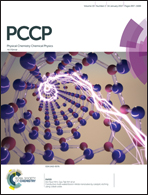Decreasing amyloid toxicity through an increased rate of aggregation†
Abstract
Amyloid β is one of the peptides involved in the onset of Alzheimer's disease, yet the structure of the toxic species and its underlying mechanism remain elusive on account of the dynamic nature of the Aβ oligomerisation process. While it has been reported that incubation of Amyloid β (1–42) sequences (Aβ42) lead to formation of aggregates that vary in morphology and toxicity, we demonstrate that addition of a discrete macrocyclic host molecule, cucurbit[8]uril (CB[8]), substantially reduces toxicity in the neuronal cell line SH-SY5Y. The macrocycle preferentially targets Phe residues in Aβ42 complexing them in a 2 : 1 fashion in neighboring peptide strands. A small but significant structural ‘switch’ occurs, which induces an increased aggregation rate, suggesting a different cell-uptake mechanism for Aβ42 in the presence of CB[8]. Dramatically increasing the rate of Aβ42 aggregation with CB[8] bypasses the toxic, oligomeric state offering an alternative approach to counter Alzheimer's disease.


 Please wait while we load your content...
Please wait while we load your content...